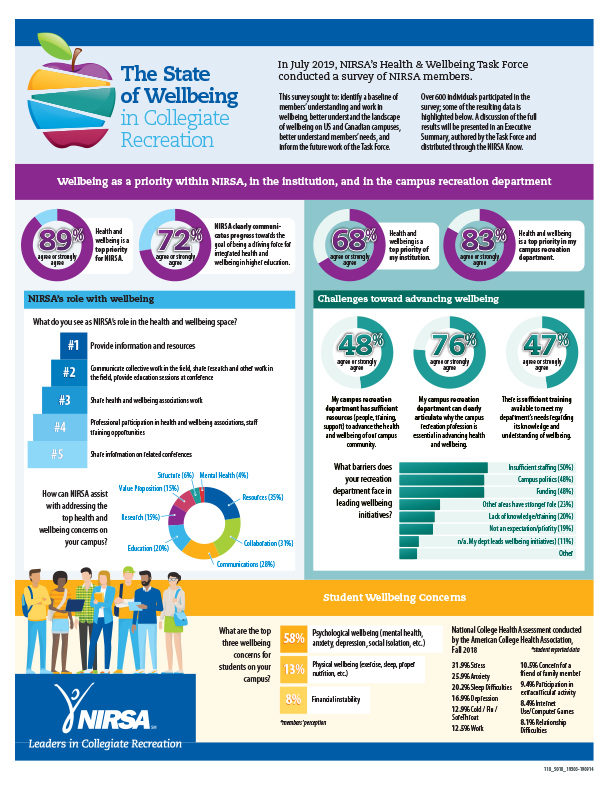Executive Summary
Details coming soon.
Introduction
The State of Wellbeing in Collegiate Recreation Survey is conducted to assist in the understanding of the current landscape of wellbeing in higher education through the lens of collegiate recreation professionals and to inform the development of future resources and support provided by the Association.
Background
The survey is distributed every two years. The first iteration was distributed in 2019, the second in 2021, and the 2023 survey was open from June 5–July 5. The 2023 survey instrument was a 34-item questionnaire inclusive of Likert scale, yes and no, and open-ended responses. The survey took an average of 14 minutes to complete.
Survey
Participants
The 2023 State of Wellbeing in Collegiate Recreation Survey, which was sent to all NIRSA members, yielded 568 responses. As a comparison, 2021 yielded 297 responses and 2019 yielded 616. There was representation from all NIRSA regions in the 2023 survey and from all categories of institution enrollment size. Similarly to the 2019 and 2021 survey results, most respondents were professional NIRSA members (89%) affiliated with public four-year institutions with greater than 10,000 students enrolled (69%). All collegiate recreation program areas were represented with the greatest number coming from administration (13%). All classifications of employment position were present with most respondents identifying as associate director and assistant director (27%).
Longitudinal Trends
Several questions were selected by the task force as key performance indicators for replication year over year to track and be responsive to shifts and changes in the landscape of wellbeing in higher education. These include:
- My campus recreation department can clearly articulate why the campus recreation profession is essential in advancing health and wellbeing
In 2019, 76% agreed or strongly agreed and in 2021, 72% agreed or strongly agreed. In 2023, this question was updated to read “I can articulate why campus recreation is essential in advancing health and wellbeing” with 93% agreeing or strongly agreeing. In 2023, 38% of respondents believed there was a difference by program area in collegiate recreation professionals’ ability to connect their work to positive impacts on wellness and wellbeing. 20% were unsure.
- I believe my level of wellbeing education is sufficient.
This item remained constant in 2019 and 2021 with 68% selecting agree or strongly agree. That pattern largely held in 2023 with 69% selecting agree or strongly agree.
- Identification of the top three departments/areas in their delegated or perceived authority to lead wellbeing initiatives on your campus.
In 2019 and 2021, the top three units identified were collegiate recreation, student health, and psychological services. In 2023, the top three units remained collegiate recreation, student health, and psychological services. From 2019 to 2021, “special wellbeing committees or task force”—while not named in the top three—showed a growth of 6%, placing it in the top five each year. In 2023, only 5% of respondents selected “special committee or task force,” placing it second to last (“other” being last).
- Number of institutions that have a special committee or task force for student wellbeing.
In 2023, 54% said there was a committee or task force. This is consistent with 2019 (52%) and 2021 (56%) responses. In 2023 we added a follow up question, asking respondents who selected yes, “Is collegiate recreation represented in this group?” 84% said yes, collegiate recreation was represented.
- Number of institutions that have “Improving students’ health, wellness, and/or wellbeing” stated in their strategic plan, vision, mission, vison, goals, and/or learning outcomes.
There were improvements between 2019 and 2021 but it was difficult to determine the level of detail or validity of responses. This question was changed in 2023 to “Improving students health, wellness and/or wellbeing is stated in”:
| Campus Rec Dept | Division | Institution | |
| Mission | 21% | 16% | 15% |
| Vision | 17% | 13% | 11% |
| Values | 17% | 15% | 14% |
| Learning Outcomes | 12% | 11% | 6% |
| Strategic Plan | 14% | 17% | 22% |
| Goals | 18% | 15% | 14% |
- Health and wellbeing is a top priority of my institution.
In 2023, 69% agreed or strongly agreed compared to 66% in 2019 and 2021.
- Health and wellbeing is a top priority of my collegiate recreation department.
In 2023, 89% agreed or strongly agreed compared to 83% in 2019 and 89% in 2021.
Findings
Some highlighted trends that emerged in the 2023 survey include:
Student wellbeing concerns on campus
The wellbeing concerns that professionals are observing on campuses in order of most to least were: Stress (24%), Anxiety (22%), Depression (10%), Time Management (8%), Financial Insecurity (6%), Sleep Hygiene (6%), Physical Health (5%), and Other Mental Health (5%).
*Additional items that were cited by <4.9% of respondents were not included in the summary
Education & Knowledge
When asked if they could articulate the value of collegiate recreation in enhancing student wellbeing, 93% agreed or strongly agreed; however, when asked if there was a disparity between professionals by program area, 57% were unsure or said yes. This leads the research group to believe that the population of survey takers may be skewed toward those working in wellbeing or there is a gap in the profession’s perceived abilities between professionals. There was a split between respondents who believe they receive sufficient training to meet campus needs with 36% agreeing or strongly agreeing that they do and 29% disagreeing or strongly disagreeing.
When asked what training has been and what training would be most beneficial, most responses pointed to offerings outside of their collegiate recreation department such as mental health first aid, wellness coaching certifications, public health courses, counseling center training, and health center training. Several respondents specifically requested the development of training specific to collegiate recreation settings.
Resources, Structure & Influence
25% of survey respondents stated the shared inter-association definition of wellbeing is currently being utilized by collegiate recreation while 35% were unsure. When asked if their campus has adopted the Okanagan Charter, 10% selected yes while 31% were unsure.
When asked if their collegiate recreation department had sufficient resources (people, training, support) to advance wellbeing, 45% of respondents agreed or strongly agreed and 36% disagreed or strongly disagreed.
When asked what their perceived barriers to leading wellbeing efforts were, the top three responses were: Staffing (21%), Campus Politics (20%), and Funding (19%).
Assessment & Telling Our Story
When asked what methods of data collection they are currently utilizing to tell their wellbeing story, 24% of respondents said facility utilization metrics, 22% of respondents said department program evaluations, 17% use participant testimonials, 13% said data from campus student surveys, 12% highlighted campus wide/national instruments (e.g., NCHA), and 10% relied on national data or trends. Respondents were able to select all that applied.
Conclusion
The Health & Wellbeing Task Force looks forward to continuing to dig into this data to deepen its understanding and use the findings to help inform its work. Overall, many of the key indicators the task force has been monitoring have remained consistent including that wellbeing is important to campus recreation and the profession sees itself as a co-leader in this work on campus.
There is an interesting discrepancy between individuals’ self-reported ability to make connections between their work and fostering wellbeing (93% agreed or strongly agreed with “I can articulate why campus recreation is essential in advancing health and wellbeing”) and how they perceived the abilities of their peers in the field (nearly 58% said there either was a difference or they were unsure if there was a difference “by program area, in collegiate recreation professionals’ ability to connect their work to positive impacts on wellness and wellbeing”). One possible reason for this may be found in looking at commonalities among survey respondents, such as positionality in department or job responsibilities. This is an area to be looked at more closely.
As in the past, this survey continues to help guide the NIRSA Health & Wellbeing Task Force in understanding what the needs of the profession are—particularly when it comes to future education. The survey shows there is an opportunity to provide more guidance around how to utilize some key resources and frameworks, such as the inter-association wellbeing definition and the Okanagan Charter. There is significant variation in instruments and methods being used by recreation departments to speak to the impact of their work on wellbeing efforts. There is also a clear ask for education that specifically speaks to the campus recreation profession’s work within the larger campus wellbeing work. The NIRSA Health & Wellbeing Task Force is already undertaking work to provide education and resources to members in all of these areas.



